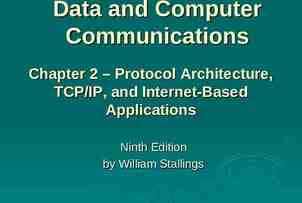IoT in HVAC and IP Controls Clifford Milligan – Controls
19 Slides1.97 MB
IoT in HVAC and IP Controls Clifford Milligan – Controls Specialist Patton Air Conditioning September 5th, 2019 [email protected]
What Does IoT Stand for? Internet of Things – A system of interrelated computing devices, mechanical and digital machines, objects, animals or people that are provided with unique identifiers (UIDs) and the ability to transfer data over a network without requiring human-to-human or human-to-computer interaction.
IoT Data Data comes from everywhere
Benefits of IoT Monitoring the HVAC components and the environment provides data which can be used for planning purposes as well as determining how people are using the services in the building.
IoT in HVAC monitoring and diagnostics Analyzing the data allows them to know when a piece of equipment is about to fail or whether there is a need for repair or maintenance.
Aren’t we doing this already? Yes we are Currently, most control systems including HVAC control systems installed are providing many of the benefits listed below: – Remotely access and monitoring – Generating alarm on failures and sending these alarms via email or text to facility managers. – Trend data and even some analytics
So What’s The Big Deal? 1. Even though we are getting the data to the ‘internet’, it can be cumbersome and antiquated. 2. The data can also be proprietary or not easily shared with other IoT systems. 3. Is the data getting to the ‘internet’ securely? Today we are going to discuss item #1
Current HVAC Controls Network
MSTP/LON/Proprietary Communications Every field bus communication is old and slow They all require some kind of ‘supervisory’ device to route the data to the ‘internet’ BACnet MSTP is an RS485 technology which was created in the 70’s. You have to not only match the protocol, but you have to match the baud rate
IP Solution IP SOX IP BACnet IP Modbus Sensors/Meters Web/Cloud based Tools, Customers UI Server, Hosted UI Server or Analytics Server
IP Communications Speed, Speed and more Speed. Most IP controllers are at least 100 mbps. Some are heading towards 1 gbps. No supervisory controller needed. All IP controllers directly communicate to data servers. NO protocol restrictions! BACnet/Modbus/Sedona/ETC. Doesn’t matter
IP Topology
Where do we go from here? Embrace the future of IP Controllers Get to know IT departments!!! Let the communications experts deal with the communications. Let the building HVAC techs deal with HVAC sensors/controllers.
IP Address per Controller Don’t let the ‘we don’t have enough IP address to give out’ excuse be the excuse. IvP4 address scheme will handle over 4 billion address.
Cyber Security Moving forward, Cyber Security is the top issue. Educate yourself on VPNs/VLANs.
Case Study – Fruitvale School District 5 sites all with failing proprietary RS-485 communication. Each site network infrastructure was being upgraded. New CAT6, Switches, etc. Added new drop for each HVAC equipment as part of that project. Customer only had to replace controller. 400 IP controllers on customers network IT Department maintains and manages communication.
Case Study – Table Mountain Casino Failing proprietary RS-485 communication. Installed new complete BMS IP network with fiber backbone. 150 IP controllers on new BMS IP network, independent from customers network.
Case Study – Multiple MOB locations Fresno/Bakersfield/Lancaster Failing proprietary RS-485 communication at multiple sites. Customer is a property developer with no network infrastructure at any site. Installed new complete BMS IP network at each site. SaaS – Cloud hosted services.
Questions? Clifford Milligan – Controls Specialist Patton Air Conditioning September 5th, 2019 [email protected]
























